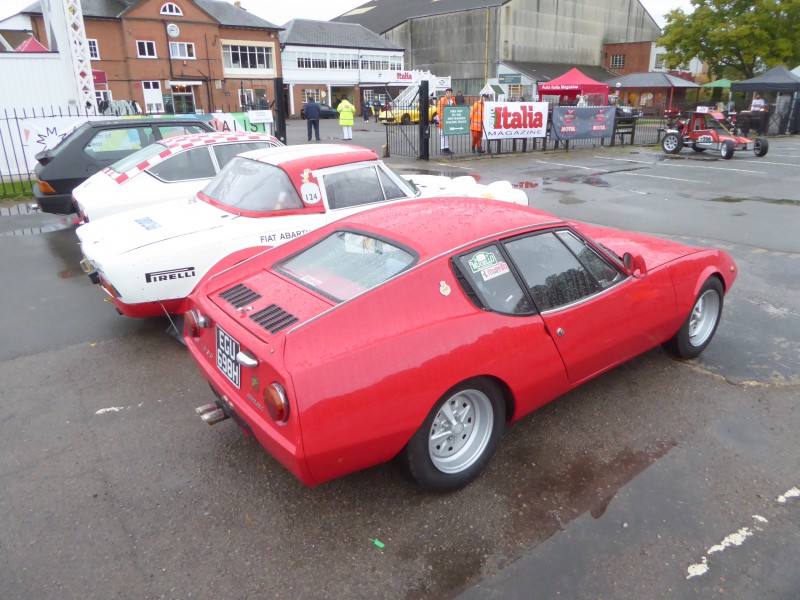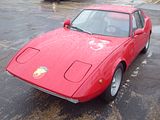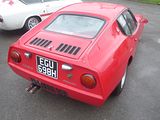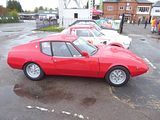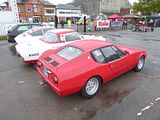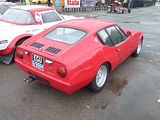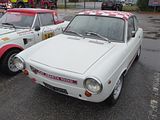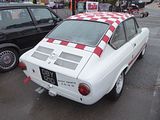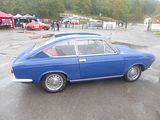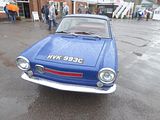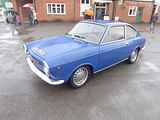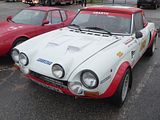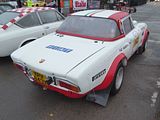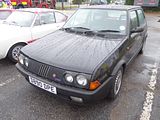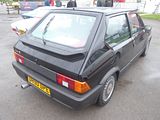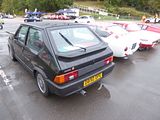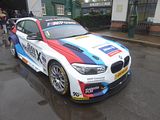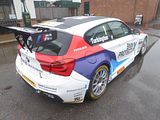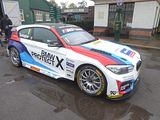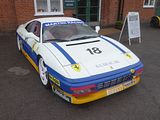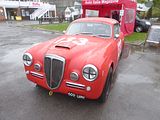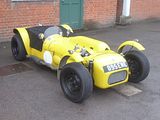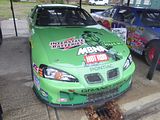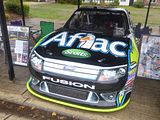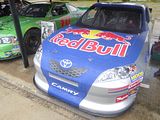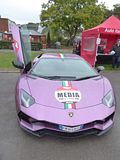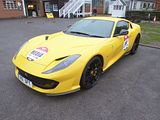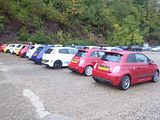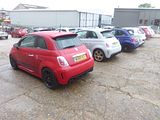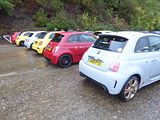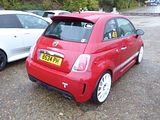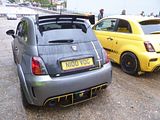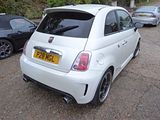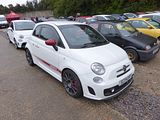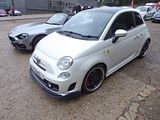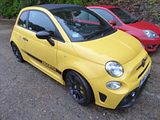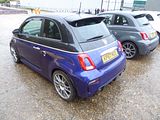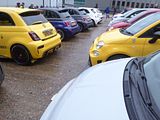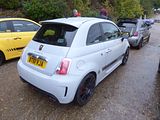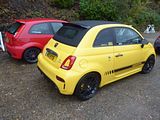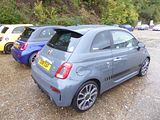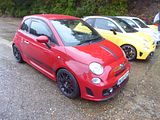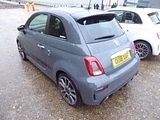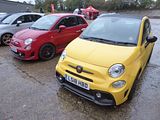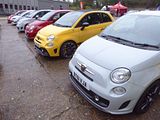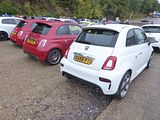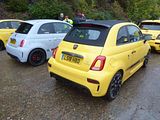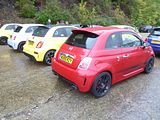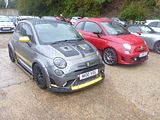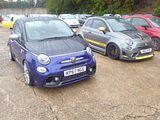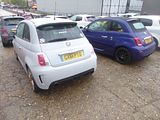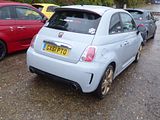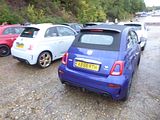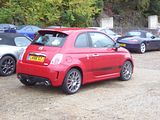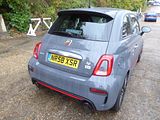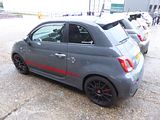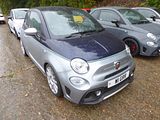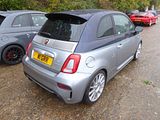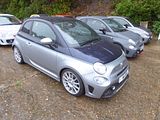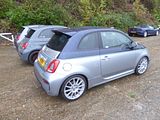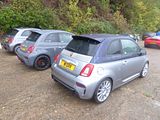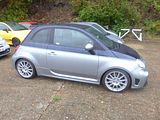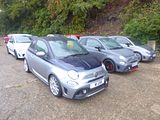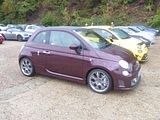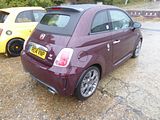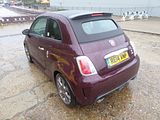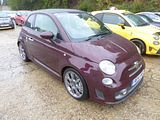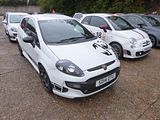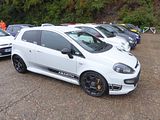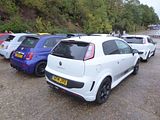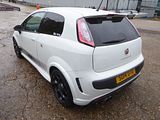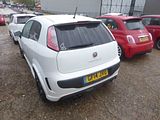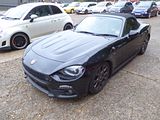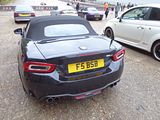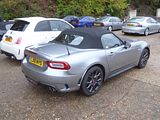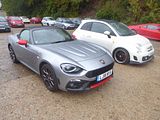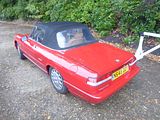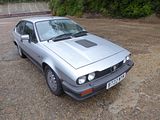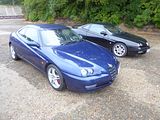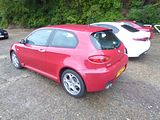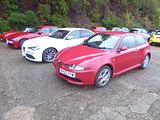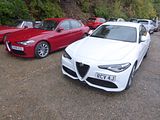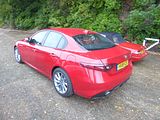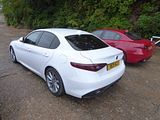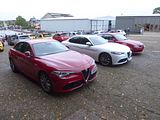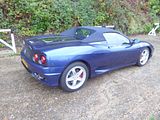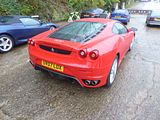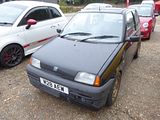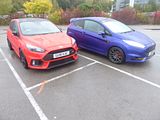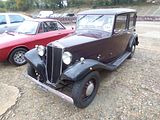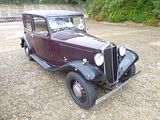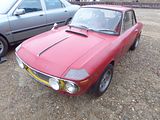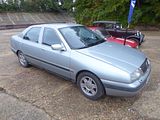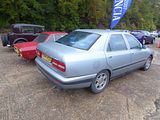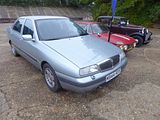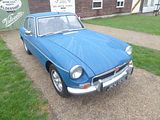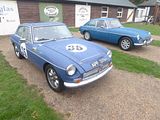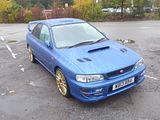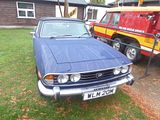The Autumn Motor Sport event is the third of a trio held during the course of a year at the iconic Brooklands site, organised by Phil Ward, the now retired editor of Auto Italia magazine, through his associated events company. First held in 2011, in the early years there was a very strong Italian bias both to the display of motor sport cars and the associated Car Clubs present, but as word has got out about the event, there has been lots of interest shown by those with cars from other nations as well, and in recent years there has been a wide variety of content at the event, reflecting almost all genres of motor sport from around the world. As well as static displays, many of the cars can be seen in action doing a number of parade laps around the adjoining Mercedes-Benz world track over lunchtime, and then in the middle of the afternoon, the Test Hill opens, with the chance for a larger group of attendees to have a go. I’ve attended every Autumn Motor Sport day since inception. The first couple were bathed in glorious autumn sunshine, and then in 2013, there was almost total washout, with unrelenting rain challenging all but the most determined. A mid October timing probably exposes a UK event to no different a risk of this from other times in the year, and there is usually at least one event a season which is similarly afflicted, so that seemed just to be unlucky, and it was certainly no deterrent to organiser or attendee in following years, when plenty of sporting cars, Car Club cars and fans all congregated on site to create what would be for most people the last outdoor event of a busy season. A few days before the 2018 running of the event, the forecasters were predicting glorious sunshine, but as the days got closer, they changed their minds completely, and declared that it would be a wet day. This turned out to be something of an understatement. The heavy showers of the day were somewhat localised, but I can quite understand how someone would see what was falling out of the sky early on the morning of the event and would conclude that this was not the day to be outdoors. Indeed, had I been at home, that would probably have been what I decided – however, reluctantly – to do. But I had been in Paris, and landed early on the Sunday morning at Heathrow. It was drizzling when the plane touched down, but by the time I was ready to able to leave the terminal, it was chucking it down, and I got soaked just dashing the few yards from the POD to my car, which did cause me to question whether I should really be pointing the car at Brooklands or home, and indeed whether anyone else would bother. I decided to give it a go, and although Brooklands is only around 10 miles from Heathrow, by the time I got there, it was not actually raining at all. I was pleased to see that as I pulled onto site, I was in a queue of cars, which meant that I would not be entirely alone. The forecast did say that there would be very heavy rain from 11am – and they were not wrong, as it really hammered it down around this time – but that meant a good couple of hours to see what was there and to decide how long to stay. Here is what I did see in the time spent at the event.
MOTORSPORT CARS
The historic motorsport cars are all grouped around the Club House buildings, and most of them tend to arrive early, so if you get on site as the gates open, as I did, you can expect to see what is there. I’d actually been sent the running order for the lunchtime demos, which had wetted the appetite, with around 50 cars from all genres to historic racing and rallying to NASCAR all entered. Given the weather, it was not a surprise to find relatively few cars actually on site before I was, and only a few more arrived during the course of the morning, Here are the majority of the vehicles which did brave the conditions.
ABARTH
Perhaps the least familiar of the historic Abarth models in the special display in front the Club House was this 1000 Scorpione, a car which was seen at UK events in 2017, following its arrival in the country after a number of years in the now closed Maranello Rosso collection in San Marino. It is based on the Lombardi Grand Prix, a car most have probably never heard of, which was a small, rear-engined sports car, based on Fiat 850 underpinnings, developed by the Carrozzeria Francis Lombardi with an in-house design by Giuseppe Rinaldi. It was first shown in March 1968, at the Geneva Motor Show. The design had a Kammback rear and a very low nose with flip-up headlights, and a large single windshield wiper. The headlights were electrically powered. The bodywork was all steel, except the rear panel. The design was originally shown as a prototype based on the front-wheel drive Autobianchi A112, and was adapted by Lombardi for the 850 sedan’s floorpan. At the 1969 Turin Show, a targa version was also shown; called the “Monza”, this open model has a rollover bar. At least two were built but it is unknown whether any were sold. The original Lombardi Grand Prix had the regular 843 cc Fiat 850 engine with 37 PS at 5000 rpm, coupled to a four-speed gearbox. Low drag resistance and weight (630 kg or 1,390 lb) meant that this was supposedly enough for a top speed of 99 mph. Later production models had the 850 Special engine, with 47 PS at 6400 rpm – in a period German test the maximum speed of the more powerful variant was 95.6 mph. Luggage space is limited, with very little space next to the spare wheel up front and with a tiny area behind the seats. In case the electric wind-up mechanism for the headlights should fail, there is also a mechanical lever underneath the bonnet. The single round tail lights are Fiat 850 Coupé units. The front suspension consists of a transverse leaf spring on the bottom and A-arms on top, while the rear received coil sprung semi-trailing arms. The Lombardi Grand Prix was built in two series: early models used the regular, metal engine cover from the Fiat 850 while the Series II has a louvred unit in black metal. The door windows are also different, being of a three-piece design (one on top, two lower pieces of which one could be slid open) while later cars have a more conventional layout with a vent window up front and a single piece which, however, could only be rolled halfway down. A Cypriot casino owner and millionaire had also shown interest in the Lombardi Grand Prix around the time of its introduction. Frixos Demetriou intended to market the car in the United Kingdom and began planning for an order of 1000 cars. After his death in a British Army tank accident in Cyprus, this project came to a sudden halt. Only ten cars were imported into the UK, with the remaining parts languishing in storage in Turin. A few unsold cars were re-exported to Cyprus in 1969 to avoid pending customs bills. The story gets more complex than that. The tiny OTAS company (Officina Trasformazioni Automobili Sportive, or “Sports car conversion shop”) was founded in 1969 and was a collaboration between Francis Lombardi and Franco Giannini – the son of Domenico Giannini of Giannini Automobili – allowing for a more powerful, Giannini-engined Grand Prix model to be marketed abroad. The resulting OTAS Grand Prix has a tuned, 982 cc twin-cam “Tigre” engine. In Italy, this model was sold as the “Giannini 1000 Grand Prix” (beginning in 1969). In a very convoluted operation, Francis Lombardi sold engineless cars to Giannini, while Giannini sold their engines to OTAS for sale outside of Italy. Responding to interest in the important North American market, OTAS also sold the Grand Prix in the United States and in Canada as the “OTAS Grand Prix 820cc”, to give the tiny car its full name. Going on sale in 1970 it was fitted with the same down-sleeved 817 cc version of the inline-four engine as used in federalised Fiat 850s – all to sneak under 50 cubic inches, thereby avoiding the need to carry emissions controls equipment. Sixty-five of these cars were brought to North America, or perhaps as many as a hundred. Fiat 850 chassis numbers were retained for the OTAS 820. Importer John Rich of Glendale, California, also offered tune-up kits directly and Siata International in New Jersey imported nine of the bigger Tigre-engined cars before the strictures of the EPA put a halt to such activities. This was the first car to have US sales curtailed by the EPA. The OTAS was sold until 1971, when the company shut its doors following homologation troubles. The car never sold particularly well, being expensive considering its performance and with a tendency to overheat. Along with other tuners (such as Giannini), Carlo Abarth also had a look at the Grand Prix. Abarth’s version, first seen at the 1968 Paris Motor Show, received a tuned version of the larger 903 cc engine from the recently introduced Fiat 850 Sport Coupé/Sport Spider. The resulting variant has a claimed 52 PS, providing performance more suitable to the sporting bodystyle and name. For better cooling than the original Lombardi and OTAS, Abarth mounted the cooler up front, in the air stream. In 1970 Abarth showed the considerably more powerful “Abarth 1300 Scorpione”, which was to be Abarth’s last independently developed car. Equipped with a version of the Fiat 124s 1.2 litre engine, bored out by 2.5 mm for a total of 1280 cc, this model has 75 PS and only moderately more weight, ranging from 680 to 750 kg (1,500 to 1,650 lb) depending on the source. In a 1970 road test by Auto, Motor und Sport, the Scorpione reached 109.1 mph, close to the claimed 112 mph. There is also mention of a 982 cc Abarth 1000 OT-engined version of the Scorpione. The Scorpione had a special Abarth-made bell housing, to allow matching the 124 engine to the four-speed 850 gearbox. After Abarth was taken over by Fiat in 1971, the Scorpione was quickly cancelled.
When I first arrived, there was an example of the OT1000 Coupe parked up, and by lunchtime a second one had arrived. These were based on the Fiat 850 Coupe. Abarth produced several tuned versions of the Fiat 850 range in three body styles: Berlina, Coupé, and Spider, and with ever-increasing displacements. They were called the OT series—standing for Omologata Turismo or “touring homologated” – and this Abarth range also included two-seater sports racing cars. The Fiat-Abarth OT 850 was Abarth’s first 850 derivative, introduced in July 1964. Its Tipo 201 engine was the regular saloon’s 847 cc inline-four brought from 34 bhp to 44 bhp. The top speed went up accordingly from 75 mph (120 kn/h) to 81 mph (130 km/h). The OT 850 could be distinguished from the standard Fiat model by its Abarth badging, an asymmetric front ornament with the Abarth shield on the right hand side and the “Fiat Abarth” script on a red field on the left, and wheels with cooling slots. From October of the same year it became available in two guises: OT 850 Oltre 130 (“Over 130”), almost unchanged from the initial model, and OT 850 Oltre 150, with a 52 bhp engine, front disc brakes and a 150 km/h (93 mph) top speed. In October 1964, Abarth added the Fiat-Abarth OT 1000. With engine displacement increased to 982 cc, it produced 60 bhp and 58 lb·ft of torque. The front brakes were changed to discs. Coupe and Spider models would follow from 1965, initially with the same 982cc enigne, but it was not long before 1300, 1600 and then 2 litre engines were inserted in the car. There are not many of these in any body style in the UK, but of those that you do see, the Coupe would seem to be the most numerous.
Probably better known is the original 124 Spider. The full name is the Fiat Abarth 124 Rally, a street legal rally version of the 124 Sport Spider sold to the masses, known also as “124 Abarth Stradale”, introduced in November 1972. Its main purpose was to receive FIA homologation in the special grand touring cars (group 4) racing class, and replace the 1.6-litre Fiat Sport Spider rally cars which were at until then being campaigned. At the time 124 had already won the 1972 European Rally Championship at the hands of Raffaele Pinto and Gino Macaluso. The 124 Rally was added to the Sport Spider range, which included the 1600 and 1800 models; the first 500 examples produced were earmarked for the domestic Italian market. Amongst the most notable modifications over the standard spider there were independent rear suspension, engine upgrades, lightweight body panels, and a rigid hard top. In place of the usual rear solid axle, there is independent suspension from lower wishbones, the original trailing arms, an upper strut and an anti-roll bar. At the front a radius rod on each side was added to the standard double wishbones. The Abarth-tuned type 132 AC 4.000 1.8-litre, twin-cam engine was brought from the standard 118 to 128 PS DIN (126 hp) by replacing the standard twin-choke carburettor with double vertical twin-choke Weber 44 IDFs, and by fitting an Abarth exhaust with a dual exit exhaust. The 9.8:1 compression ratio was left unchanged. The transmission is the all-synchronised five-speed optional on the other Sport Spider models, and brakes are discs on all four corners. Despite the 20 kg (44 lb) four-point roll bar fitted, kerb weight is 938 kg (2,068 lb), roughly 25 kg (55 lb) less than the regular 1.8-litre Sport Spider. Engine bonnet, boot lid and the fixed hard top are fibreglass, painted matt black, the rear window is perspex and the doors aluminium. Front and rear bumpers were deleted and replaced by simple rubber bumperettes. A single matte black wing mirror was fitted. Matte black wheel arch extensions house 185/70 VR 13 Pirelli CN 36 tyres on 5.5 J × 13″ four-spoke alloy wheels. Inside, the centre console, rear occasional seats, and glovebox lid were eliminated; while new features were anodised aluminium dashboard trim, a small three-spoke leather-covered Abarth steering wheel, and Recaro corduroy-and-leather bucket seats as an extra-cost option. The car carries Fiat badging front and rear, Abarth badges and “Fiat Abarth” scripts on the front wings, and Abarth wheel centre caps. Only three paint colours were available: Corsa red, white, and light blue.
Final model in this grouping was a car which technically is a Fiat, but which bore Abarth badging, as this was from the era when the brand was somewhat moribund. This is a Strada 130 TC. Launched in 1983 in Europe and arriving in the UK in the summer of 1984, it was based on the 125 TC, which had never been sold in the UK. The 130TC was powered by a 1,995 cc engine with power output increased to 130 PS. This was achieved by replacing the single Weber carb used in the 125 TC with twin Solex/Weber carburettors on a side-draught manifold, and via improved cam profiles. The 130 TC had a top speed of 195 km/h (121 mph) and accelerated from 0 to100 km/h (62 mph) in 7.8 seconds. It was fitted with Recaro bucket seats in Britain (optional in Europe) and it remained the only 1980s European hot hatch to continue to utilise carburettors instead of fuel injection. Ignition timing was controlled electronically. Although appearing outwardly similar to the restyled 105 TC with its lower door and wheelarch trims, the 130 TC could be distinguished by its polished four-spoke alloy wheels (continued from the earlier 125 TC), aerodynamic perspex front door wind deflectors, and lower hatchback spoiler. The powerful twin-cam was mated to a close ratio five-speed ZF manual gearbox and had superior performance to its contemporary rivals, which included the Volkswagen Golf GTI, Ford Escort XR3i, Vauxhall Astra GTE and the MG Maestro. It did not sell in large numbers but these days it is the Strada you are most likely to see.
BENTLEY
Somehow appropriate for a venue steeped in British motor sport history, this 3 litre car is the sort of machine that the brace drivers would have pounded round the banking when the car was new. These days it epitomise the classic Bentley to many people. The 3 Litre was the company’s first model, first shown in 1919 and made available to customers’ coachbuilders from 1921 to 1929. It was conceived for racing. The Bentley was very much larger than the 1368 cc Bugattis that dominated racing at the time, but double the size of engine and strength compensated for the extra weight. The 4000 lb (1800 kg) car won the 24 Hours of Le Mans in 1924, with drivers John Duff and Frank Clement, and again in 1927, this time in Super Sports form, with drivers S. C. H. “Sammy” Davis and Dudley Benjafield. Its weight, size, and speed prompted Ettore Bugatti to call it “the fastest lorry in the world.” The 3 Litre was delivered as a running chassis to the coachbuilder of the buyer’s choice. Bentley referred many customers to their near neighbour Vanden Plas for bodies. Dealers might order a short cost-saving run of identical bodies to their own distinctive design. Most bodies took the simplest and cheapest form, tourers, but as it was all “custom” coachwork there was plenty of variation. The 2,996 cc straight-4 engine was designed by ex-Royal Flying Corps engineer Clive Gallop and was technically very advanced for its time. It was one of the first production car engines with 4 valves per cylinder, dry-sump lubrication and an overhead camshaft. The four valve SOHC Hemi design, with a bevel-geared shaft drive for the camshaft, was based on the pre-war 1914 Mercedes Daimler M93654 racing engine. Just before the outbreak of the war Mercedes had placed one of the winning Grand Prix cars in their London showroom in Long Acre. At the suggestion of W.O. Bentley, then being commissioned in the Royal Naval Air Service, the vehicle was confiscated in 1915 by the British army, dismantled at Rolls-Royce and subjected to scrutiny. A notable difference to both the Mercedes and the aero engines was the cast-iron monobloc design, and the fully Aluminium enclosed camshaft, which greatly contributed to its durability. But having the valve-head and block in one-piece made for a complicated and labour intensive casting and machining. This was a feature shared during that time by the Bugattis which the car was later to compete with. The engine was also among the first with two spark plugs per cylinder, pent-roof combustion chambers, and twin carburettors. It was extremely undersquare, optimised for low-end torque, with a bore of 80 mm (3.1 in) and a stroke of 149 mm (5.9 in). Untuned power output was around 70 hp, allowing the 3 Litre to reach 80 mph. he Speed Model could reach 90 mph; the Super Sports could exceed 100 mph. A four-speed gearbox was fitted. Only the rear wheels had brakes until 1924, when four-wheel brakes were introduced. There were three main variants of the 3 litre and they became known by the colours commonly used on the radiator badge. There was a definite rule controlling badge colours but astonishingly it has since been established that given “special circumstances” the factory would indeed supply a “wrong” colour. Blue label was the standard model with 117.5 in wheelbase from 1921 to 1929 or long 130.0 in wheelbase from 1923 to 1929. The Red label used a 5.3:1 high compression engine in the 117.5 in wheelbase chassis and was made from 1924 to 1929. The Green label was made between 1924 and 1929 and was the high performance model with 6.3:1 compression ratio and short 108 in wheelbase chassis. 100 mph performance was guaranteed. As well as 3 Experimental cars, Bentley produced 1088 examples of the 3 litre, and the Speed Model numbered 513 and there were 18 Super Sports.
BMW
Sole BMW here was this, Colin Turkington’s 125i M-Sport from the 2017 BTCC series.
FERRARI
There were a couple of Ferrari models here, though annoyingly, I don’t seem to have taken a picture of the older of the duo, a 1958 250 GT Coupe. I did, however, capture, this one, a 355 Challenge car, at rest.
LANCIA
Designed by Vittorio Jano, the Lancia Aurelia was launched in 1950 and production lasted until the summer of 1958. The very first Aurelias were the B10 Berlinas. They used the first production V6 engine, a 60° design developed by Francesco de Virgilio who was, between 1943 and 1948 a Lancia engineer, and who worked under Jano. The first cars had a capacity of 1754 cc, and generated 56 hp. During production, capacity grew from 1.8 litres to 2.5 litres across six distinct Series. Prototype engines used a bore and stroke of 68 mm x 72 mm for 1569 cc; these were tested between 1946 and 1948. It was an all-alloy pushrod design with a single camshaft between the cylinder banks. A hemispherical combustion chamber and in-line valves were used. A single Solex or Weber carburettor completed the engine. Some uprated 1991 cc models were fitted with twin carburettors. At the rear was an innovative combination transaxle with the gearbox, clutch, differential, and inboard-mounted drum brakes. The front suspension was a sliding pillar design, with rear semi-trailing arms replaced by a de Dion tube in the Fourth series. The Aurelia was also first car to be fitted with radial tyres as standard equipment. Aurelia was named after Via Aurelia, a Roman road leading from Rome to France. The B21 version was released in 1951 with a larger 1991 cc 70 hp engine and a 2-door B20 GT coupé appeared that same year. It had a shorter wheelbase and a Ghia-designed, Pininfarina-built body. The same 1991 cc engine produced 75 hp in the B20. In all, 500 first series Aurelias were produced. This is generally believed to the first car to use the name GT, or Gran Turismo. The B20 GT Aurelia had a successful career in motorsport, too. In the 1951 Mille Miglia the 2-litre Aurelia, driven by Giovanni Bracco and Umberto Maglioli, finished 2nd beaten only by the Ferrari America. The same year it took first in class and 12th overall at LeMans. Modified Aurelias took the first three places on 1952’s Targa Florio with Felice Bonetto as the winner and another win on Lièges-Rome-Lièges of 1953.
LOTUS
The running order I saw before the event showed two historic Lotus models were booked in, but, not entirely surprisingly, given the complete absence of weather protection, only one of them was here. This is a Mark VI, a precursor to the legendary Seven. After building multiple trials and road racing cars, Colin Chapman introduced his first ‘production’ car, the Lotus Mark VI, in 1952. The heart of the Mark VI was a space frame chassis. Rather than a complete car, it was available to the general public as kit, wherein the customer could install any preferred engine and gearbox, making it eligible for a wider number of formulae. The Mark VI in many ways reflected Chapman’s background in engineering: his designs resulted from a stress analysis of loads into the frame, they were extremely light (the 6′ space frame weighed only 55 lbs), and the suspension incorporated the latest advances. The prototype chassis was built up by the Progress Chassis Company and the aluminium body was constructed by panel beaters Williams and Prichard. (Both firms would later furnish bodies and chassis for subsequent models.) The cheap and easily available mechanical parts were sourced from the Ford Prefect. The Mark VI became a popular sight on Britain’s racetracks, and was a frequent winner, beating many more powerful and expensive cars, earning praise for very good handling and superior low-speed acceleration. An important facet of the success of the kit was Chapman’s offering a comprehensive package in the Mark VI, including most of the special parts needed, and not just the chassis. The Mark VI chassis came with mounting points for several different engines including the 1172cc Ford 10, the 1250 cc or 1500 cc MG TF, the 1500cc Consul, and the exalted Coventry Climax. Standardised as far as possible for volume production, some units were customised per the owners wishes. Lotus even modified the owner’s parts, if needed. When fitted with the 1172cc Ford engine, and a 3 speed gearbox, the car put out 50 bhp at 5000 rpm, and generated 57 lb/ft of torque, which gave the car a 0 – 60 time of 15 seconds and a top speed of 93 mph. The success of the Mark VI in competition and sales – 100 had been built by 1955 – established Chapman as a manufacturer of specialty cars.
NASCAR
There were three of these NASCAR models, from America’s popular racing series. These never cease to surprise with me with just how much noise they generate when fired up and in motion, though on this occasion, I only saw them in static mode.
COURSE CARS
There were a couple of course cars here, used to lead the groups of historic cars around the track in the lunchtime activity. They were to be seen in the area in front of the clubhouse during the rest of the day. Both were current supercars, unsurprisingly, and generated lots of interest especially from the younger attendees of the day. The Lamborghini Aventador was not a complete surprise, as I had seen preview messages suggesting that pink Lamborghini was going to be present, and when seen in the metal, it proved to be not quite as startlingly garish as I had perhaps expected. Presented alongside it was the latest version of Ferrari’s 2 seater GT, the 812 Superfast, also in a bright colour, which suits the shape of the car well. You could not really either of these cars “pretty” in a way that some of their predecessors were, but every angle, vent, grille and other feature is there for a reason, so perhaps “purposeful” is the best word to describe the pair.
CAR CLUBS
The whole of the area approaching the Banking, what was the old Start/Finish straight, as well as places around the museum buildings was reserved for Car Club display cars. In previous years, there have been strong showings from a significant number of Clubs, with this element constituting an event in and of itself. Not so on this occasion, with many Club Owners deciding to stay somewhere rather less soggy than an event like this, which, whilst a pity, is quite understandable.
ABARTH
That all said, it would seem that the message of the weather forecast either did not get through to Abarth Owners or many of them chose to ignore it. Granted that unlike some of the older cars that other Clubs would have brought along, these are modern cars, with the oldest being still in its first decade. Even so, that around 25 cars turned up, and stayed for several hours has to count as not just the impressive showing that it was, but a true reflection of the enthusiasm of many Abarthisti for their cars, the brand, for meeting fellow enthusiasts and for attending events.
Most numerous were the 500-based cars, as you would expect, with over 20 of these little rockets in the group. These ranged from a couple of well-loved early Esseesse models, those belonging to PAUL Feldman, whose car is still pretty standard and Paul Hatton, who has modified his more than somewhat. That balance between as they left the factory and those which have been personalised applies across the others here, with Nico Vogli’s car – well known at Abarth gatherings – also far from standard, but plenty of others which were as Abarth supplied them. There was a good array of colours, and spec here, too, and a mix of the regular hatch and the 595C model.
Among them were a few limited production cars. Neil Rollinson’s 695 XSR Yamaha Limited Edition. The Yamaha connection is perhaps not obvious, til you remember that in 2017, for the third year running, Abarth were the Official Sponsor and Official Car Supplier of the Yamaha Factory Racing Team which competed in the 2017 FIM MotoGP World Championship. So following on from the Abarth 595 Yamaha Factory Racing and the 695 biposto Yamaha Factory Racing Editions that they have already made, there was another limited edition car, the Abarth 695 XSR Yamaha Limited Edition, available exclusively in Pista Grey. Just 695 hatches and 695 convertibles were made, to celebrate the Yamaha XSR900 Abarth, along with the first exclusive motorcycle to spring from the collaboration between the two brands and which sported the same grey livery with red trim as the 695 XSR, as well as sharing many of its features. The special series made extensive use of carbon fibre to demonstrate its affinity with the front fairing, front mudguard and saddle cover of the two-wheel Yamaha. The Abarth 695 XSR and the Yamaha XSR900 Abarth also share Akrapovič ultralight exhaust developed in the racing world to boost the personality, sound and performance of both vehicles. On the Abarth car, the carbon fibre tailpipes enhance the looks and technology of the exhaust system. The XSR logo on the tailgate distinguishes the Abarth 695 XSR, while an aluminium badge identifies the sequential number of 695 units for each body type. Other carbon fibre details, in addition to the mirror caps and Akrapovič tailpipes, are available as optional equipment, such as dashboard fascia, pedal covers, gear knob and kick plate. A 1.4 T-Jet engine delivering 165 HP sits beneath the bonnet. Equipment on this special series includes Koni rear suspension and Eibach springs, 17” Supersport alloy rims with Matt Black finish, Satin Chrome accents on handles and badge supports, red details on bumpers and mirrors, red brake callipers and a braking system with perforated discs. This version can be customised even further using the tuning kit to increase the power to 180 HP, improve handling by fitting a Koni front suspension with FSD (Frequency Selective Damping) valve and make braking even prompter with 305x28mm perforated and self-ventilating Brembo floating front discs with high-performance Ferodo HP 1000/1 front brake pads. It also features the UconnectTM 7″ HD LIVE system integrated with Apple CarPlay allows iPhone users to access contents such as Apple Maps, Messages, telephone calls, Apple Music, also with Siri voice assistance. These cars proved popular among Abarth Owners Club members and it is not unusual to see several of them at the same event.
Whilst taking shelter from the 11am downpour, we noticed a 695 Rivale model had joined the ranks. This is the latest celebration of Fiat’s partnership with Riva, which has already seen a special Riva version of the 500,. Described as being “the most sophisticated Abarth ever”, it is available either as a hatch or a cabriolet, with both of them featuring a two-tone Riva Sera Blue and Shark Grey paintwork. The Rivale is adorned with an aquamarine double stripe, satin chrome finish on the door handles and satin chrome moulding on the tailgate, various aesthetic elements inspired by the Riva 56 Rivale yachts and ‘695 Rivale’ logos, joined by Brembo Brakes, Koni suspension, and 17-inch Supersport alloy wheels. Enhancing the nautical theme the new 695 Rivale features either a carbon fibre or mahogany dashboard, black mats with blue inserts, blue leather seats and door panels, carbon fibre kick plates, special steering wheel wrapped in blue and black leather and with a mahogany badge, blue leather instrument panel cover, and mahogany gear lever knob and kick plate. These are joined by the standard Uconnect infotainment with a 7-inch display, which is compatible with Android Auto and Apple CarPlay, and there is also a hand-written numbered plate that can be customised with the mane of the customer’s yacht on request. Powering the 695 Rivale is the same 1.4-litre turbocharged engine that makes 180PS (177hp) and 184lb/ft of torque, that features in the 595 Competizione, allowing it to go from rest to 100km/h (62mph) in 6.7 seconds and up to a top speed of 225km/h (140mph). This is a regular model in the range, but confusingly, there is also the Abarth 695 Rivale 175 Anniversary, created to celebrate 175 years of the Riva brand. Just 350 of these were produced, half of them the hatch and the other half cabriolets. These featured 17-inch alloy wheels with a special pattern, celebratory badge on the outside, hand-crafted details such as the two-tone colour – blue and black hand-stitched leather seats with a celebratory logo stitched onto the headrest, carbon dashboard silk screen printed with special logo, numbered plate. Standard Rivale cars arrived in the UK in April, and quite a few have been sold. They always attract lots of interest when they do appear.
Also arriving during the deluge was a 695 Edizione Maserati. This one belongs to Neil Potter (“Curly”), but I never actually found him on site before I left. Unveiled at the 2012 Geneva Show, the Edizione Maserati was limited to 499 vehicles and was a version of the Abarth 500C with 1.4 Turbo T-Jet 16v engine rated at 180 bhp, a 5-speed electrically operated manual Abarth Competizione gearbox with steering wheel controls, Maserati “Neptune” 17″ alloy wheels with performance tyres, Brembo 305 mm brake discs with fixed four-piston caliper and special shock absorbers, Record Modena variable back-pressure “dual mode” exhaust, Pontevecchio Bordeaux body colour, Xenon headlights with dipped and driving light functions, sand beige Poltrona Frau leather seats with containment strips featuring single-layer padding and the pista grey contrasting electro-welding, black leather steering wheel, aluminium pedal unit and sill plate, carbon fibre kick plate, boosted hi-fi audio system. Around 20 of them came to the UK, so you don’t see them very often.
There were a couple of Punto models here. Both were SuperSport models, a limited edition version added to the range in 2012. Easily identified by the distinctive black bonnet, just 199 of these were built, of which around 120 are registered on UK roads. These cars had many of the options from the Punto Evo included as standard. Power came from the the 1.4-litre MultiAir turbo engine, tuned to produce 178bhp and 199lb ft of torque, up from 165 of the standard Punto Evo, giving the SuperSport a 0-62 time of 7.5 seconds and a top speed of over 132mph. To help put the power down, the SuperSport was fitted with wider 18″ wheels and optional Koni FSD dampers. Standard equipment included the Blue&Me infotainment system with steering wheel controls, automatic climate control and a popular option was the ‘Abarth Corsa by Sabelt’ sports leather seats. The SuperSport was available in the same colours as the regular Punto Evo, which means white, grey, black and red. The last of these is the rarest by some measure, and indeed on this occasions, both cars – those belonging to Olav Svendsen and James King – were both white ones.
Completing the display were a pair of 124 Spider models, with Owners Club Chairman, Bertie Bryant’s black car joined by a more recent grey one. The Abarth 124 Spider was developed in parallel with the Fiat model and launched at the same time, at the end of 2015, with UK deliveries starting in September of 2016. The Abarth version does cost a lot more than the Fiat and indeed the Mazda MX5 with which it shares much under the skin, and there are those who think you don’t get enough extra for your money, but those who have driven it will tell you otherwise. You certainly get more power. The 1.4 MultiAir turbo unit jumps up from 138bhp to 168bhp, while torque also increases by a modest 10Nm to 250Nm, which gives it a 0-62mph time of 6.8 seconds, which is half a second quicker than the 2.0-litre Mazda MX-5. The top speed is 143mph. It weighs just 1060kg meaning a power-to-weight ratio of 158bhp-per-tonne, and with the Record Monza exhaust system it sounds great even at idle. The Abarth version gets a stiffer suspension setup than the regular Fiat 124 Spider, with Bilstein dampers and beefed-up anti-roll bars. Bigger Brembo brakes also feature, with aluminium calipers. It can be had with a six-speed manual or six-speed automatic transmission with paddles, and the latter gets a Sport mode for quicker shifts. The car seen here was sporting the ‘Heritage Look’ pack, which is a no-cost option. It brings a matt black bonnet and bootlid, plus red exterior trim detailing and is likely to be popular. The £29,565 starting price gets you standard equipment such as cruise control, climate control, Bluetooth, a DAB radio and satnav, plus Alcantara black and red (or pure black) seat trim. The automatic gearbox is a £2,035 extra, while an optional visibility pack brings LED DRLs, auto lights and wipers and rear parking sensors. Around 500 have now been sold in the UK, so this is still quite a rare car.
ALFA ROMEO
The Alfa Romeo Owners Club display was right behind the Abarth area, and before entering I had seen a picture of their van and marquee which my friend Nick Wright, who runs AROC had entered. Alfa Owners are a hardy lot, like Abarth owners, so I knew that they would not leave him alone, and indeed during the morning, a number of Alfa models did arrive. Not surprisingly, most of them were relatively recent cars, but even so, these all feel “special” compared to some of their market rivals, so just as no-one moaned that the Abarths were “too modern”, so no-one was going to say that about the Alfa cars, either.
Oldest, from a design point of view was this fabulous S4 Spider. The S4 marked the final major change to the long running 105 Series Spider when it came out in 1990. Mechanically, the biggest different was the use of Bosch Motronic electronic fuel injection with an electric fan. Externally, the Spider lost its front under-bumper spoiler and the rather ungainly rear boot spoiler of the S3, and picked up 164-style rear lights stretching across the width of the car as well as plastic bumpers the same colour as the car. This also marked the first generation of the car with automatic transmission, as well as on-board diagnostics capabilities. The car had remained in production largely thanks to continued demand in North America, though this market had to wait until 1991 for the changes to appear on their cars. European markets were offered a car with a 1600cc engine and carburettors as well as the 2 litre injected unit. As with the earlier S3, the car was not sold new in the UK by Alfa Romeo, but a number of them were imported at the time, and more have found their way to the UK since. Some, such as Simon’s car have been converted to right hand drive, which makes the car more usable in the UK. Production finally ended in 1993, with an all new model, the 916 Series Spider appearing a year later.
As was still the practice in the 1970s, Alfa followed up the 1972 launch of the Alfetta Berlina with a very pretty coupe. Styled by Giugiaro, this car, initially called the GT, and premiered in the autumn of 1974, looked completely unlike the saloon on which it was based. The first cars had 1.8 litre four cylinder engines and there was one of those on show. In 1976 the range was expanded both up and down with a 1.6 and a 2.0 model, the latter adopting the legendary GTV name. A rare SE model from this period was part of the display, complete with period vinyl roof (look closely), and although the pain does appear a bit like a lot of older Alfa reds, having gone rather pink, this was the actual shade when the car was new. In 1981, with the 2.5 litre V6 engine that had been developed for the ill-fated Alfa 6 luxury saloon available, Alfa was able to create a true rival for the 2.8 litre Capri with the GTV6. A facelift modernised the look of the car with plastic bumpers front and rear and a new interior looked rather better as well as being more ergonomically logical. There was one of these later plastic bumpered models here.
The 916 Series cars were conceived to replace two very different models in the Alfa range. First of these was the open topped 105 Series Spider which had been in production since 1966 and by the 1990s was long overdue a replacement. Alfa decided to combine a follow on to the Alfetta GTV, long out of production, with a new Spider model, and first work started in the late 1980s. The task was handed to Pininfarina, and Enrico Fumia’s initial renderings were produced in September 1987, with the first clay models to complete 1:1 scale model made in July 1988. Fumia produced something rather special. Clearly an Italian design, with the Alfa Romeo grille with dual round headlights, recalling the Audi-based Pininfarina Quartz, another design produced by Enrico Fumia back in 1981, the proposal was for a car that was low-slung, wedge-shaped with a low nose and high kicked up tail. The back of the car is “cut-off” with a “Kamm tail” giving improved aerodynamics. The Spider would share these traits with the GTV except that the rear is rounded, and would feature a folding soft-top with five hoop frame, which would completely disappear from sight under a flush fitting cover. An electric folding mechanism would be fitted as an option. Details included a one-piece rear lamp/foglamp/indicator strip across the rear of the body, the minor instruments in the centre console angled towards the driver. The exterior design was finished in July 1988. After Vittorio Ghidella, Fiat’s CEO, accepted the design, Alfa Romeo Centro Stile under Walter de Silva was made responsible for the completion of the detail work and also for the design of the interiors, as Pininfarina’s proposal was not accepted. The Spider and GTV were to be based on the then-current Fiat Group platform, called Tipo Due, in this case a heavily modified version with an all new multilink rear suspension. The front suspension and drivetrain was based on the 1992 Alfa Romeo 155 saloon. Chief engineer at that time was Bruno Cena. Drag coefficient was 0.33 for the GTV and 0.38 for the Spider. Production began in late 1993 with four cars, all 3.0 V6 Spiders, assembled at the Alfa Romeo Arese Plant in Milan. In early 1994 the first GTV was produced, with 2.0 Twin Spark engine. The first premiere was then held at the Paris Motor Show in 1994. The GTV and Spider were officially launched at the Geneva Motor Show in March 1995 and sales began the same year. The cars were well received. At launch, many journalists commented that Alfa had improved overall build quality considerably and that it came very close to equalling its German rivals. I can vouch for that, as I owned an early GTV for eighteen months, and it was a well built and reliable car. In 1997 a new engine, a 24-valve 3.0 litre V6, was available for the GTV along with bigger, 12.0 inch brakes and red four-pot calipers from Brembo. The console knobs were changed from round central to rectangle ones and to a three-spoke steering wheel. Some versions were upgraded with different front bumper mesh to bring the wind noise down to 74 dBA. In May 1998 the cars were revamped for the first time, creating the Phase 2 models. Most of the alterations were inside. The interior was changed with new centre console, painted letters on skirt seals, changed controls and switches arrangement and different instrument cluster. Outside, the main changes included chrome frame around the grille and colour-coded side skirts and bumpers. A new engine was introduced, the 142 hp 1.8 Twin Spark, and others were changed: the 2.0 Twin Spark was updated with a modular intake manifold with different length intakes and a different plastic cover. Power output of the 2.0 TS was raised to 153 hp. Engines changed engine management units and have a nomenclature of CF2. The dashboard was available in two new colours in addition to the standard black: Red Style and Blue Style, and with it new colour-coded upholstery and carpets. The 3.0 24V got a six-speed manual gearbox as standard and the 2.0 V6 TB engine was now also available for the Spider. August 2000 saw the revamp of engines to comply with new emission regulations, Euro3. The new engines were slightly detuned, and have a new identification code: CF3. 3.0 V6 12V was discontinued for the Spider and replaced with 24V Euro3 version from the GTV. 2.0 V6 Turbo and 1.8 T.Spark were discontinued as they did not comply with Euro3 emissions. By the 2001-2002 model year, only 2 engines were left, the 2.0 Twin.Spark and 3.0 V6 24V, until the Phase 3 engine range arrived. The Arese plant, where the cars had been built, was closing and, in October 2000, the production of GTV/Spider was transferred to Pininfarina Plant in San Giorgio Canavese in Turin. In 2003 there was another and final revamp, creating the Phase 3, also designed in Pininfarina but not by Enrico Fumia. The main changes were focused on the front with new 147-style grille and different front bumpers with offset numberplate holder. Change to the interior was minimal with different centre console and upholstery pattern and colours available. Instrument illumination colour was changed from green to red. Main specification change is an ASR traction control, not available for 2.0 TS Base model. New engines were introduced: 163 hp 2.0 JTS with direct petrol injection and 237 hp 3.2 V6 24V allowing a 158 mph top speed. Production ceased in late 2004, though some cars were still available for purchase till 2006. A total of 80,747 cars were made, and sales of the GTV and Spider were roughly equal. More V6 engined GTVs than Spiders were made, but in 2.0 guise, it was the other way round with the open model proving marginally more popular.
Having a rather short production life was the GTA version of the 147. Launched in 2002. this car was intended to compete with the most sporting Golf and Focus models of the day. as well as injecting more potency into a range which always seemed like it needed more power. Fitted with a 3.2 V6 engine which produced 247 bhp, the 147GTA was the most powerful hot hatch available at the time, and the modifications to the body, including lower sills and wider wheel arches, if anything, made it look even better rather than endowing it with the sort of “after market look” that can afflict some high end performance versions of regular family cars. Performance figures were impressive, with the car able to achieve a top speed of 153 mph. It had a widened body by 15 mm at each side to accommodate the 225/45R17 tyres. Most models had a 6-speed manual transmissions; whilst a smaller number of other models used the semi automatic Selespeed system. Production ran through to 2004 and in total 5,029 147 GTAs were built, 1004 of which were Selespeeds. Only around 300 came to the UK, so this was never a common sighting on British roads. This rather nice example arrived during the morning.
Although the Giulia is still far from an everyday sighting on our roads, you can be pretty sure that at gatherings of Alfa models and Italian cars in general, there will be a number of the present, and that was the case here, with three of them in the display. Even the “regular” cars are nice, of course, but it is the Quadrifolgio which has gathered most of the headlines and the approbation from the world’s motoring press who have struggled to find the marque’s models as class leaders for a very long time, and there was one of those included in the show as well.
Rounding things off was one of the family-sized Giulietta hatches. These have been on sale since 2010, and although they’ve never found huge number of buyers in any give year, there was plenty of them around, even on UK roads, and there is enthusiastic owner affection for them, with several using being manifest at events like this.
FERRARI
Ferrari owners are notorious for their reluctance to bring their cars out in the rain, so although a sizeable area was allocated to examples of the marque, on the other side of the Abarth area from where the Alfas were to be found, it was no surprise that after an hour on site, there were no examples at all. And then, all of a sudden we noticed a couple of cars heading towards their allotted area. Older of the pair was a 360 Spider. It was with the 360 Modena that sales of Ferrari models really took off, with unprecedented volumes of the car being sold. The 360 Modena was launched in 1999, named after the town of Modena, the birthplace of Enzo Ferrari. A major innovation in this all new model came from Ferrari’s partnership with Alcoa which resulted in an entirely new all-aluminium space-frame chassis that was 40% stiffer than the F355 which had utilised steel. The design was 28% lighter despite a 10% increase in overall dimensions. Along with a lightweight frame the new Pininfarina body styling deviated from traditions of the previous decade’s sharp angles and flip-up headlights. The new V8 engine, common to all versions, was of 3.6 litre capacity with a flat plane crankshaft, titanium connecting rods and generates 400 bhp Despite what looks like on paper modest gains in reality the power to weight ratio was significantly improved on over the F355, this was due to the combination of both a lighter car and more power. The 0 to 100 km/h acceleration performance improved from 4.6 to 4.3 seconds. The first model to be rolled out was the 360 Modena, available as a manual, or an F1 electrohydraulic manual. Next up was an open car. The 360 was designed with a Spider variant in mind; since removing the roof of a coupe reduces the torsional rigidity, the 360 was built for strength in other areas. Ferrari designers strengthened the sills, stiffened the front of the floorpan and redesigned the windscreen frame. The rear bulkhead had to be stiffened to cut out engine noise from the cabin. The convertible’s necessary dynamic rigidity is provided by additional side reinforcements and a cross brace in front of the engine. Passenger safety is ensured by a strengthened windscreen frame and roll bars. The 360 Spider displays a curvilinear waistline. The fairings imply the start of a roof, and stable roll bars are embedded in these elevations. Due to use of light aluminium construction throughout, the Spider weighs in only 60 kg heavier than the coupé. As with the Modena version, its 3.6 litre V8 with 400 bhp is on display under a glass cover. The engine — confined in space by the convertible’s top’s storage area — acquires additional air supply through especially large side grills. The intake manifolds were moved toward the center of the engine between the air supply conduits in the Spider engine compartment, as opposed to lying apart as with the Modena. In terms of performance, the 0-60 mph time was slightly slower at 4.4 seconds due to the slight weight increase, and the top speed was reduced from 189 to 180 mph. Despite the car’s mid-mounted V8 engine, the electrically operated top is able to stow into the compartment when not in use. The convertible top was available in black, blue, grey and beige. The transformation from a closed top to an open-air convertible is a two-stage folding-action that has been dubbed “a stunning 20 second mechanical symphony”. The interior of the Spider is identical to that of the coupé.
The other Ferrari here was an F430. Effectively a mid-life update to the 360 Modena, the F430 debuted at the 2004 Paris Motor Show. Designed by Pininfarina, under the guidance of Frank Stephenson, the body styling of the F430 was revised from the 360 Modena, to improve its aerodynamic efficiency. Although the drag coefficient remained the same, downforce was greatly enhanced. Despite sharing the same basic Alcoa Aluminium chassis, roof line, doors and glass, the car looked significantly different from the 360. A great deal of Ferrari heritage was included in the exterior design. At the rear, the Enzo’s tail lights and interior vents were added. The car’s name was etched into the Testarossa-styled driver’s side mirror. The large oval openings in the front bumper are reminiscent of Ferrari racing models from the 60s, specifically the 156 “sharknose” Formula One car and 250 TR61 Le Mans cars of Phil Hill. Designed with soft-top-convertible. The F430 featured a 4.3 litre V8 petrol engine of the “Ferrari-Maserati” F136 family. This new power plant was a significant departure for Ferrari, as all previous Ferrari V8’s were descendants of the Dino racing program of the 1950s. This fifty-year development cycle came to an end with the entirely new unit. The engine’s output was 490 hp at 8500 rpm and 343 lb/ft of torque at 5250 rpm, 80% of which was available below 3500rpm. Despite a 20% increase in displacement, engine weight grew by only 4 kg and engine dimensions were decreased, for easier packaging. The connecting rods, pistons and crankshaft were all entirely new, while the four-valve cylinder head, valves and intake trumpets were copied directly from Formula 1 engines, for ideal volumetric efficiency. The F430 has a top speed in excess of 196 mph and could accelerate from 0 to 100 km/h in 3.9 seconds, 0.6 seconds quicker than the old model. The brakes on the F430 were designed in close cooperation with Brembo (who did the calipers and discs) and Bosch (who did the electronics package),resulting in a new cast-iron alloy for the discs. The new alloy includes molybdenum which has better heat dissipation performance. The F430 was also available with the optional Carbon fibre-reinforced Silicon Carbide (C/SiC) ceramic composite brake package. Ferrari claims the carbon ceramic brakes will not fade even after 300-360 laps at their test track. The F430 featured the E-Diff, a computer-controlled limited slip active differential which can vary the distribution of torque based on inputs such as steering angle and lateral acceleration. Other notable features include the first application of Ferrari’s manettino steering wheel-mounted control knob. Drivers can select from five different settings which modify the vehicle’s ESC system, “Skyhook” electronic suspension, transmission behaviour, throttle response, and E-Diff. The feature is similar to Land Rover’s “Terrain Response” system. The Ferrari F430 was also released with exclusive Goodyear Eagle F1 GSD3 EMT tyres, which have a V-shaped tread design, run-flat capability, and OneTRED technology. The F430 Spider, Ferrari’s 21st road going convertible, made its world premiere at the 2005 Geneva Motor Show. The car was designed by Pininfarina with aerodynamic simulation programs also used for Formula 1 cars. The roof panel automatically folds away inside a space above the engine bay. The conversion from a closed top to an open-air convertible is a two-stage folding-action. The interior of the Spider is identical to that of the coupé. Serving as the successor to the Challenge Stradale, the 430 Scuderia was unveiled by Michael Schumacher at the 2007 Frankfurt Auto Show. Aimed to compete with cars like the Porsche RS-models and the Lamborghini Gallardo Superleggera it was lighter by 100 kg/220 lb and more powerful (510 PS) than the standard F430. Increased power came from a revised intake, exhaust, and an ion-sensing knock-detection system that allows for a higher compression ratio. Thus the weight-to-power ratio was reduced from 2.96 kg/hp to 2.5 kg/hp. In addition to the weight saving measures, the Scuderia semi-automatic transmission gained improved “Superfast”, known as “Superfast2”, software for faster 60 millisecond shift-times. A new traction control system combined the F1-Trac traction and stability control with the E-Diff electronic differential. The Ferrari 430 Scuderia accelerates from 0-100 km/h in 3.6 seconds, with a top speed of 202 miles per hour. Ferrari claimed that around their test track, Fiorano Circuit, it matched the Ferrari Enzo, and the Ferrari F430’s successor, the Ferrari 458. To commemorate Ferrari’s 16th victory in the Formula 1 Constructor’s World Championship in 2008, Ferrari unveiled the Scuderia Spider 16M at World Finals in Mugello. It is effectively a convertible version of the 430 Scuderia. The engine produces 510 PS at 8500 rpm. The car has a dry weight of 1,340 kg, making it 80 kg lighter than the F430 Spider, at a curb weight of 1,440 kg (3,175 lb). The chassis was stiffened to cope with the extra performance available and the car featured many carbon fibre parts as standard. Specially lightened front and rear bumpers (compared to the 430 Scuderia) were a further sign of the efforts Ferrari was putting into this convertible track car for the road. Unique 5-spoke forged wheels were produced for the 16M’s launch and helped to considerably reduce unsprung weight with larger front brakes and callipers added for extra stopping power (also featured on 430 Scuderia). It accelerates from 0-100 km/h in 3.7 seconds, with a top speed of 315 km/h (196 mph). 499 vehicles were released beginning early 2009 and all were pre-sold to select clients.
FIAT
There were just two Fiat models here, and both decided to park among the Abarth models, which did not go down well with some of the Abarth owners. Given the overall turnout, I really did not have the same problem that others did, and anyway these were both nice cars, dating from the 1990s.
Developed as the Tipo 175, the Coupe was introduced at the Brussels Motor Show in 1993. It is perhaps best remembered for its distinctive, angular design, with unique scalloped side panels. The body was designed by Chris Bangle from Centro Stile Fiat, while the interior was designed by Pininfarina, and the car media headlines in auto magazines during 1992 after several spy shots were taken revealing the car on test. On its launch in 1993, the Coupé was available with a four-cylinder, 2.0 litre 16V engine, in both turbo (190 PS) and normally aspirated (139 PS) versions. Both engines were later versions of Fiat’s twin-cam design and inherited from the Lancia Delta Integrale. 1996 brought in a 1.8 litre 131 PS 16V engine (not available in the UK), along with a 2.0-litre 5-cylinder 20V (147 PS), and a 5-cylinder 2.0-litre 20V turbo (220 PS). The turbocharged 16 and 20 valve versions were equipped with a very efficient Viscodrive limited-slip differential to counter the understeer that plagues most powerful front wheel drive cars. Additionally, the coupe featured independent suspension all round: at the front MacPherson struts and lower wishbones anchored to an auxiliary crossbeam, offset coil springs and anti-roll bar; at the rear, trailing arms mounted on an auxiliary subframe, coil springs and an anti-roll bar. The car was well received at launch, and the 5 cylinder engines just made it even better, with sales increasing slightly for a couple of years, but then they started to drop off, as Coupe models in general fell from favour. 1998 saw the release of the Limited Edition which featured red Brembo brake calipers at the front and standard red calipers at the back, a body kit, push-button start, six-speed gearbox, strut brace to make the chassis more rigid and Recaro seats with red leather inserts which offered better support than the standard 20VT seats. The LE was produced in Black, Red, Vinci Grey (metallic), Crono Grey and Steel Grey (metallic). The bodywork of the LE also benefitted from titanium coloured insert around the light bezels and the wing mirrors. Each Limited Edition (‘LE’) Coupé was manufactured with a badge located by the rear-view mirror which contained that car’s unique number (it is rumoured that Michael Schumacher was the original owner of LE No. 0001, however when the question was raised to him personally he confirmed he had owned one, but a red one, while LE No. 0001 is a Crono Grey one). Originally a spokesman from Fiat stated only approximately 300 Limited Editions would be built. The final number was much higher, perhaps as many as 1400. This angered many of the owners of the original 300 cars and almost certainly impacted residual values. The original number however was quoted by a Fiat UK spokesman, so probably that number only applied to the UK market. The numbered plaque on every Coupe features enough space for 4 numbers. In 1998 the 2.0-litre 5-cylinder 20V got a Variable Inlet System which brought the power to 154 PS. The 2.0-litre 5-cylinder 20V Turbo received a 6-speed gearbox and a large, satin gloss push starter button. In addition, the sills of the Turbo version were colour matched with the body paintwork. Fiat also released the 2.0 litre 5 cylinder Turbo ‘Plus’. This model came with an option kit that made it virtually identical to the LE, except for minor interior design changes and without the unique identification badge of the LE. In 2000 Fiat released another special version of the Fiat Coupé. Featuring the 1.8-litre engine, it was only available throughout mainland Europe and marketed as an elegant and affordable edition. Fiat also made changes throughout the rest of the range: new seats, side skirts and wheels for the 2.0-litre 20V model, ‘Plus’ edition wheels on turbo models and Fiat manufactured seats on the ‘Plus’ that were virtually identical to the original Plus Recaro seats with the addition of extra airbags. The 2.0-litre 20V Turbo model is capable of accelerating from 0–100 km/h (0 to 62 mph) in 6.5 seconds and 6.3 seconds for the 20v Turbo Plus, with a top speed of 240 km/h (149 mph) or 250 km/h (155 mph) with later 6-speed gearbox. When production finally stopped in September 2000, a total number of 72,762 units had been produced. There are still well over 1000 units in the UK, so this is a Fiat which has proved durable as well as good to drive, and to look at.
Second of them was a Cinquecento, the Tipo 170 in Fiat development parlance, which was launched in December 1991, to replace the Fiat 126. It was the first Fiat model to be solely manufactured in the FSM plant in Tychy, Poland, which had been sold to Fiat by the Polish state, and where production of the Polish variant of the Fiat 126, the Polski Fiat 126p, was still running. It took 18 months before the new city car reached the UK, and its success proved that there was a market for very small cars after all, even though Renault had concluded that there was not sufficient demand for their Twingo which appeared around the same time. The Fiat sold well, and it was not long before it had a number of market rivals, such as the Ford Ka, Seat Arosa and Volkswagen Lupo. The smallest engine, intended for sale in Poland only, was a 704 cc OHV two-cylinder unit, delivering 31 bhp, an engine which was inherited from the 126p BIS. For the front-wheel drive Cinquecento, it underwent a major refurbishment (although the engine still employed a carburettor), which resulted, among other changes, in the crankshaft revolving in the opposite direction than in the 126p BIS! The bigger engine was the 903 cc 40 PS version of the veteran Fiat 100 OHV four-cylinder engine, which saw service in many small Fiat models, starting with the Fiat 850, and dating back to the initial 633 cc unit as introduced in the 1955 Fiat 600. It was fitted with single point fuel injection and was the base engine in most markets. Due to fiscal limitations, the displacement of this unit was limited to 899 cc in 1993, with a slight reduction of output, now producing 39 PS. In 1994, Fiat introduced the Cinquecento Sporting, featuring the 1108 cc SOHC FIRE 54 PS engine from the entry-level Punto of the same era, mated to a close-ratio 5 speed gearbox. Other additions were a drop in standard ride height, front anti-roll bar, 13″ alloy wheels, plus colour-coded bumpers and mirrors. The interior saw a tachometer added, along with sports seats, red seatbelts and a leather steering wheel and gear knob. It is the Sporting model which gave birth to a rallying trophy and a Group A Kit-Car version, and the Sporting is the version you see most often these days, but for once that was not the variant seen here. Production of the Cinquecento ended in early 1998, when it was replaced by the Seicento.
FORD
There were just two “fast Fords” here , looking rather lonely in the middle of the parking area. Both were recent products, and comprised the recently superceded Fiesta ST and Focus RS. The latter of these was on of the limited-to-300, £36,295 Race Red editions which was announced late last year, as a swansong for the third generation RS model. As the name suggests, it comes in only one colour, rolls as standard on black wheels and gets a standard Quaife mechanical limited-slip differential between its front wheels. Unlike the Tief Orange coloured car announced at the same time, which included as standard the Mountune M375 tuning kit that uses electronic and breathing tweaks to hike the 2.3-litre engine’s turbo power by 25bhp to 370bhp and adding 30lb ft of torque, the Race red cars were mechanically the same as the regular production models.
LANCIA
Completing the array of Italian cars on show were a trio of Lancia models. When you think of this once proud marque, it is probably the Delta Integrale which comes to mind, but there were none of those on display, instead, three rather rarer models were on show. Oldest of these was an Augusta, as produced by Lancia between 1933 and 1936. It made its première at the 1932 Paris Motor Show. The car was powered by a 1,196 cc Lancia V4 engine. During the 1920s, Lancia had been known as producers of sports cars and middle sized sedans: the smaller Augusta represented a departure from that tradition, and contributed to a significant growth in Lancia’s unit sales during the 1930s. Nevertheless, in terms of volumes sold, the Augusta was overwhelmed by Fiat’s much more aggressively priced 508 Ballila.
Rather better known is the Fulvia Coupe. Lancia replaced the long-running Appia with a new model in 1963, the Fulvia. Like the larger Flavia which had been shown 3 years earlier, it came with front wheel drive, and a host of exquisite engineering which ensure that even though it was expensive, it was actually not profitable for its maker, and was a direct contribution to the marque’s bankruptcy and take over by Fiat in 1969. It was not long before the initial Berlina saloon model was joined by a Coupe. First seen in 1965. the Coupe proved to be the longest lived of all Fulvia variants, surviving until 1976 when it was effectively replaced by the 1300cc version of the Beta Coupe. Before that, it had undergone a steady program of updates, with more powerful engines, including a capacity increase from the initial 1200cc of the narrow angle V4 to 1300 and then later 1600cc, and the car was developed into a successful rally machine for the late 60s. The Sport Zagato version was designed by Ercole Spada at Zagato and was intended to be the more sporting model of the range. It was also considerably more expensive. Early cars had an unusual side hinged bonnet, but this was changed on the Series 2 models which were launched in 1970, and which also switched to all-steel bodies. Seen here was a nice Coupe in S2 guise.
Third of the trio was a Kappa, an executive car which replaced the Thema as Lancia’s flagship model in 1994 and was itself replaced by the Lancia Thesis in 2001. It shared its platform with the Alfa Romeo 166 and was available as a saloon, estate or coupé. The Kappa was only available in left-hand drive, as Lancia pulled out of right-hand drive markets after the demise of the Thema. Kappa is the tenth letter of the Greek alphabet,so it followed a long tradition of using Greek letters to name Lancia models. Back in 1919, Lancia had already produced a Kappa (and its later evolutions called Dikappa and Trikappa), but these are far less known nowadays than the 1990s Kappa. In writing, Lancia often referred to the Kappa simply as the k (lower case “k”), which is fairly similar to the original Greek letter κ. The Kappa was not particularly popular, with only 117,216 made in total. Italy remained Kappa’s most important market, absorbing the bulk of sales. It is also worth noting that in Poland, where Fiat Auto is the biggest domestic car manufacturer, Kappas served as official government cars (replacing Themas). This boosted the Kappa’s profile in that country and gave it a peculiar cachet, which is why the Kappa enjoys a solid enthusiast base there.
MG
A small number of MG models were parked on the opposite side of the Start/Finish straight, backing onto the new museum buildings, and a couple more were parked up backing onto the older buildings. Oldest of these was a 1933 L2 Magnette. The L-type was made in 1933 and 1934. This 2-door sports car used a smaller version of the 6-cylinder overhead camshaft, crossflow engine which now had a capacity of 1086 cc with a bore of 57 mm and stroke of 71 mm and produced 41 bhp at 5500 rpm. It was previously fitted in the 1930 Wolseley Hornet and the 1931 MG F-type Magna. Drive was to the rear wheels through a four-speed non-synchromesh gearbox. The chassis was a narrower version of that used in the K-type with suspension by half-elliptic springs all round with rigid front and rear axles. The car had a wheelbase of 94 inches (2388 mm) and a track of 42 inches (1067 mm). The brakes, which were the same as in the J2, were cable-operated, with 12-inch (300 mm) drums all round. The body kept the sloping radiator seen on the F-Type, but the car now had sweeping wings, and the four-seater had cut-away doors. The L1 was the four-seat, coupé and saloon version and the L2 the 2-seater. The coupé, or Continental Coupé as it was called, was available in some very striking two-tone colours but was a slow seller, and the 100 that were made were available for a long time after the rest of the range had sold out. As a rarity, it is now a highly desirable car. The bodies for the small saloon or salonette version were not made by MG, but bought in from Abbey. The L-Type was a successful competition car, with victories in the 1933 Alpine Trial and Brooklands relay race. When new, a L1 tourer cost £299 and a Continental Coupé £350.
Launched in October 1962, the MGB was produced for the next 18 years and it went on to become Britain’s best selling sports car. When first announced, the MGB was an innovative, modern design, with a monocoque structure instead of the traditional body-on-frame construction used on both the MGA and MG T-types and the MGB’s rival, the Triumph TR series, though components such as the brakes and suspension were developments of the earlier 1955 MGA and the B-Series engine had its origins back in 1947. The lightweight design reduced manufacturing costs while adding to overall vehicle strength, and with a 95hp 3-bearing 1798cc engine under the bonnet, performance was quite respectable with a 0–60 mph time of just over 11 seconds. The car was rather more civilised than its predecessor, with wind-up windows now fitted as standard, and a comfortable driver’s compartment offered plenty of legroom. The roadster was the first of the MGB range to be produced. The body was a pure two-seater but a small rear seat was a rare option at one point. By making better use of space the MGB was able to offer more passenger and luggage accommodation than the earlier MGA while being 3 inches shorter overall. The suspension was also softer, giving a smoother ride, and the larger engine gave a slightly higher top speed. The four-speed gearbox was an uprated version of the one used in the MGA with an optional (electrically activated) overdrive transmission. A five-bearing engine was introduced in 1964 and a number of other modifications crept into the specification. In late 1967, sufficient changes were introduced for the factory to define a Mark II model. Alterations included synchromesh on all 4 gears with revised ratios, an optional Borg-Warner automatic gearbox, a new rear axle, and an alternator in place of the dynamo with a change to a negative earth system. To accommodate the new gearboxes there were significant changes to the sheet metal in the floorpan, and a new flat-topped transmission tunnel. US market cars got a new safety padded dashboard, but the steel item continued for the rest of the world. Rostyle wheels were introduced to replace the previous pressed steel versions in 1969 and reclining seats were standardised. 1970 also saw a new front grille, recessed, in black aluminium. The more traditional-looking polished grille returned in 1973 with a black “honeycomb” insert. Further changes in 1972 were to the interior with a new fascia. To meet impact regulations, in late 1974, the chrome bumpers were replaced with new, steel-reinforced black rubber bumpers, the one at the front incorporating the grille area as well, giving a major restyling to the B’s nose, and a matching rear bumper completed the change. New US headlight height regulations also meant that the headlamps were now too low. Rather than redesign the front of the car, British Leyland raised the car’s suspension by 1-inch. This, in combination with the new, far heavier bumpers resulted in significantly poorer handling. For the 1975 model year only, the front anti-roll bar was deleted as a cost-saving measure (though still available as an option). The damage done by the British Leyland response to US legislation was partially alleviated by revisions to the suspension geometry in 1977, when a rear anti-roll bar was made standard equipment on all models. US emissions regulations also reduced horsepower. In March 1979 British Leyland started the production of black painted limited edition MGB roadsters for the US market, meant for a total of 500 examples. Due to a high demand of the limited edition model, production ended with 6682 examples. The United Kingdom received bronze painted roadsters and a silver GT model limited editions. The production run of home-market limited edition MGBs was split between 421 roadsters and 579 GTs. Meanwhile, the fixed-roof MGB GT had been introduced in October 1965, and production continued until 1980, although export to the US ceased in 1974. The MGB GT sported a ground-breaking greenhouse designed by Pininfarina and launched the sporty “hatchback” style. By combining the sloping rear window with the rear deck lid, the B GT offered the utility of a station wagon while retaining the style and shape of a coupe. This new configuration was a 2+2 design with a right-angled rear bench seat and far more luggage space than in the roadster. Relatively few components differed, although the MGB GT did receive different suspension springs and anti-roll bars and a different windscreen which was more easily and inexpensively serviceable. Although acceleration of the GT was slightly slower than that of the roadster, owing to its increased weight, top speed improved by 5 mph to 105 mph because of better aerodynamics. 523,826 examples of the MGB of all model types were built, and although many of these were initially sold new in North America, a lot have been repatriated here.
The MGC was produced as a sort of replacement for the Big Healey, though apart from sharing that car’s 3 litre straight six C Series engine, the reality is that the car was quite different and generally appealed to a different sort of customer. Or, if you look at the sales figures, you could say that it did not really appeal to anyone much, as the car struggled to find favour and buyers when new. More of a lazy grand tourer than an out and out sports car, the handling characteristics were less pleasing than in the B as the heavy engine up front did the car no favours. The market now, finally, takes a different view, though and if you want an MGC, in Roadster or the MGC GT form the latter of which was to be seen here, you will have to dig surprisingly deeply into your pocket. This one belongs to Ross Harrington, who brought it as an alternative to his Abarth 595, a car he more often brings to events like this.
SUBARU
There was just one Subaru model here, parked by itself, This is a first generation WRX, a car which enjoyed huge popularity when it was new. Interest in the Impreza, initially a rather dull family car offered in 4 door saloon and 5 door “Wagonback” version took off following a combination of the launch of the Turbo version in 1994 and the model’s success in word rallying. For the next few years, a series of ever faster models were added to the range, leaving a complicated legacy (no pun intended!) of different versions which can be difficult to sort out, even before the inevitable after-market mods which many of them underwent. There were seven noted versions of the WRX dating back from Subaru’s original World Rally Cross staging vehicles. Subaru adopted the name “WRX” to stand for “World Rally eXperimental” (in some places WRX stands for “World Rally Cross”) as all WRX versions (1992 to present) feature rally inspired technology, including all wheel drive, stiffened suspensions and turbocharged four cylinder engines. The STI versions were marketed with consecutive numbers. Another way to determine the version of a WRX was to look at the chassis code. All WRX sold between 1992 and 2000 have the beginning chassis code of GC8 sedan or GF8 hatchback; this is followed by a letter from A to G. Coupe versions share the “GC” code with sedans, except in the US, where they have a separate chassis code of “GM”. In 1994, Subaru introduced Subaru Tecnica International (STI) versions of the WRX in Japan. These models were upgraded from the standard WRX in many categories, including blueprinted performance-tuned engines, transmissions, and suspensions. The STI versions of the WRX were immensely successful in rallies and popular among street racers but were only sold in the Japanese market. Compared to the WRX, the STI had mostly mechanical modifications. The WRX debuted in November 1992 with 240 PS. The centre differential was a viscous coupling type, the rear limited slip differential was a viscous type. The WRX Type RA is a stripped down version of the WRX that was available in the Japanese market for people to purchase for motorsports and tuning. Targeted for race and rally, the RA versions were generally lighter in weight; featuring reduced soundproofing, manual windows, no air conditioning, no anti-lock brakes, and added racing features such as more robust engines, driver controlled centre differentials, and shorter gearing. The WRX Type RA uses a closer ratio gearbox and a three-spoke leather steering wheel from Nardi. In Europe, the WRX was introduced as the Impreza GT, and as the Impreza Turbo 2000 (UK). It came with 208 hp. In the United Kingdom, Subaru offered six “WRX 1.8 GL” in 1993. The firm imported six Type RS’s, the development car that led to the stripped-out Type RA. Three cars went to Prodrive; three were retained by Subaru UK and were subsequently sold. For UK car certification reasons they were registered as “1.8 GL” despite having the 2.0-liter turbocharged engine. In October 1993, Subaru introduced the 1994 model year WRX which produced 240 PS. The rear rotors were substituted from ventilated disk to solid disk. October 1993 was also the start of production of the hatchback version, with 220 PS. The first STI was known simply as “WRX STI”, with 100 per month were produced starting from February 1994. It had 250 PS. This version of the STI was the only version where the standard cars were taken at the end of the assembly line and replaced by STI parts. An STI version of the Type RA was also offered, again with many amenities deleted to reduce weight and cost. Producing 275 PS, this version of the WRX STI came with a Driver Controlled Centre Differential (DCCD). This device was an electromechanical differential that could lock the differential. In November 1994, the WRX had a power increase to 260 PS. The wheel diameters were increased to 16 inches and brake rotors were both changed to ventilated disks. In Japan, the WRX engine was also offered with the hatchback body variant and was called the “Impreza Gravel Express” but was discontinued due to very limited sales. To commemorate Colin McRae’s success in the international rally scene, Subaru in the UK released 200 limited edition “Series McRae” WRXs in June 1995, prepared by Prodrive. These vehicles were finished in a very limited “Rally Blue” colour scheme, sported gold 16-inch alloy wheels, McRae decals, individual numbered badging from 1–201 (car 13 was never built since the number 13 is considered unlucky), and a factory-fitted electric tilt/slide sunroof. Recaro seats were fitted in the front, and the rear seats and side panels were retrimmed in the same Le Mans/Avus material. The regular STI’s engine output stood at 275 PS. The car weighed 1,240 kg (2,734 lb) and had gold wheels like those on the World Rally Championship Impreza. Now, the STI was built alongside the WRX on the production lines. The 1996 model year WRX debuted in January 1996. The WRX design received minimal mechanical changes, but a WRX V-Limited Edition was introduced to celebrate the success of the Impreza WRC car in the FIA WRC. It was mechanically the same to the WRX but had a curb weight nudge to 1,240 kg (2,734 lb). The V-limited cars are painted in World Rally Blue. A WRX STI V-limited edition was also produced. The interior is coloured blue on the seat inserts and carpeting. The WRX Type RA STI received a radio and air-conditioning in the V-limited form. 1,000 WRX STI Version 2 V-limited were produced, with 555 WRX Type RA STI Version 2 V-limited models produced. In September 1996, the WRX was updated with new styling. The WRX now has a power rating of 280 PS and now weighed 1,250 kg (2,756 lb). Although it actually developed about 300 PS, the output was under-reported at the then-established gentlemen’s agreement power limit of 280 PS. Subaru in the UK released the WRX “Catalunya” in March 1997, a limited production of 200 cars (again excluding car number 13) in black with red flecks riding on gold alloy wheels. The Catalunya was made to celebrate winning Subaru’s second WRC manufacturer’s title at the Rally of Spain (Catalunya). With GC8D came the start of the coupé version of the WRX STI. It is called the WRX Type R STI. The coupé was chosen by Prodrive for use in the WRC because it was lighter and stiffer than the sedan, although it carried the same exterior dimensions. It was essentially a two-door version of the WRX Type RA STI meaning it had DCCD, minimal sound insulation, close-gear ratios and hardened gearbox. This car also has a water-spray nozzle to dampen the top of the intercooler. The water will then evaporate, taking heat away from the intercooler and cooling the intake charge. This car was produced on an order-only basis. An estimated 10,000 Type R models were produced for the Japanese Domestic Market. Also, there was a WRX STI type RA (sedan) available, with a roof vent instead of map lights, and wind up windows, although electrics are an option from factory. Also available was a WRX Type R V-limited. It has a WRX motor with no forged internals like the STI, and it misses out on the four-pot front brakes as they are to be installed by rally teams. It has a roof vent and is lightweight, making a good base for a rally car. In Europe, the Subaru Impreza WRX GT’s (Turbo 2000 in UK) interior was updated to leather. For the STI, power remained at 280 PS. Forged pistons were also added. The interior and the cockpit were changed into a newer design along with the new white coloured gauges. For the UK, the WRX “Turbo Terzo” was released in April 1998. 333 cars in blue with gold alloy wheels were produced to celebrate Subaru’s WRC title. In 1998, Subaru of Japan produced a widebody, coupe WRX STI called the “22B STI” produced between March and August 1998. The 22B was used to commemorate both Subaru’s 40th anniversary as well as the third consecutive manufacturer’s title for Subaru in the FIA World Rally Championship. On the release of the sales, all 400 Japanese units sold out in from 30 minutes to 48 hours, depending on the report. Another 24 were produced for export markets—16 for the UK, along with another 5 for Australia, and 3 prototypes. The 16 cars imported to the UK were modified by Prodrive, with longer gear ratios, and UK specification lights. Because 50 22Bs had already been imported privately into the UK, Subaru had to wait until 1999 to register the 16 officially imported cars under the VCA’s Single Vehicle Approval scheme. The 22B had the EJ22G engine (note, the internal Subaru material states the closed-deck block comes from a version 3 EJ20G). This means the displacement was increased from 1,994 cc to 2,212 cc, bored up to 96.9 mm. Officially, it produced 280 PS @ 6,000 rpm and 268 lb/ft @ 3,200 rpm of torque, fuel feed by Electronic Fuel Injection and a IHI RHF 5HB turbocharger. This car was given a unique colour of blue and had fender flared widebody taken from the Peter Stevens designed WRC car, thus widening the width by 80 mm (3.15 inches). The car has a unique hood, front and rear fenders, a WRC-inspired front bumper and a unique adjustable rear wing. During assembly, a WRX Type R chassis was taken off the line. The wings were replaced with the 22B STI ones. The suspension is provided by Bilstein, while the brakes were four-pot front/two-pot rear STi calipers, painted red. The wheels were increased in size from the standard WRX Type R STI from 16- to 17-inches and the clutch was upgraded to a sintered twin clutch with a ceramic disk. The origin of the name 22B has been debated. The 22 referred to the 2.2-litre displacement and the B was thought to be for the Bilstein suspension. This would correlate with the idea that Subaru sells a Legacy Spec B, where the B represents the Bilstein suspension. However, the B is actually a Subaru internal code for Turbo. 22B is also the hexadecimal conversion for the number 555, Subaru’s major sponsor in the WRC. The car’s curb weight is 1,270 kilograms (2,800 lb). Mechanically the GC8F was virtually the same as its predecessor. The torque was increased a little from 242 to 250 lb/ft at 4000 rpm. The weight also continued to increase, at 1,300 kg (2,800 lb). To celebrate the return of British driver Richard Burns to the rally team, a limited edition of 444 WRX “RB5” models in grey were created in 1999 for the UK. The basic model had little more than cosmetic differences, but most had the WR Sport Performance Pack, an option consisting of a new ECU and exhaust for 240 PS and 258 lb/ft torque. There was also an optional Prodrive suspension pack. The standard UK Impreza Turbo 2000 was also tuned and partly restyled by Prodrive in 1999 to create the WRX “Prodrive WR Sport”. It featured a unique interior, suspension upgrade, new bodykit and wheels, plus WR Sport decals and an optional ECU upgrade. For the STI, the power stayed the same as the previous version but the engine layout and design was made cleaner and was dubbed as the “Boxer Phase 2” engine. The facelift the rest of the Impreza line had was also applied to the STI. The WRX STI weighed 1,270 kg (2,800 lb). There were 1000 WRX Type RA STI Version 5 Limited cars and each had a four-month waiting period. The interior was also changed slightly, including seats and steering. This model was also produced as a 555 limited edition. The last version of the GC WRX was introduced on September 1999. There is no change in the mechanical specifications. Added features are newly designed alloy wheels, colour-coded mirrors and door handles, remote central locking, intermittent wipers with a timer and map lights. The European WRX turbo model received further upgrades in the form of more parts from the STI range. The front brakes became Subaru branded four-pot calipers with 11.6 inch discs, the wheels having become 16-inch lightweight alloys. The STI 4 high-level wing was fitted to the sedan, and STI-style front bucket seats and firmer suspension were also fitted. The “Phase 2” engine now fitted developed 218 PS, an increase of 7 PS over the previous model. To counter the grey imports of high-performance Japanese variants, Subaru UK commissioned Prodrive to produce a limited edition of 1,000 two-door cars in Sonic Blue, called the WRX “P1”. Released in March 2000, they were taken from the STI Type R lines and used for the P1. The car was the only coupé version of the WRX STI GC chassis to receive ABS. In order to allow for ABS, the DCCD was dropped. Engine output was boosted to 276 bhp, and the suspension optimised for British roads. Options were available from Subaru consisting of four-piston front brake calipers, electric Recaro seats, 18-inch wheels and a P1 stamped backbox. The P1, or Prodrive One, is echoed in the name of the Prodrive P2 concept car. Likewise, for the STI, most of the changes were cosmetic with the wings being sculpted to be more aggressive. There were 2,000 WRX STI Version 6 Limited model produced, plus 1000 of the WRX STI Type R coupe Version 6 Limited, 2,000 of the WRX STI RA Version 6 Limited, and also 500 of the WRX STI Version 6 Limited hatchback models. In 2000, STI released the WRX STI “S201”, of which 300 were produced. This series is a limited production series that sports an engine output of 305 PS as special variants were excluded from the gentlemen’s agreement. The car was decked with nearly every single part from the STI catalogue. The S201 was a sedan that sported the only body-kitted S-series WRX STI. Weighing in at 1,270 kg (2,800 lb), the S201 had a tri-planar wing and a massive front airsplitter. The entire suspension was composed of STI parts. You don’t see these cars in anything like the numbers you used to at events like this.
TRIUMPH
Sole Triumph model here was an example of the Stag. Envisioned as a luxury sports car, this car was designed to compete directly with the Mercedes-Benz SL. It started as a styling experiment, cut and shaped from a 1963–4 Triumph 2000 pre-production saloon, which had also been styled by Michelotti, and loaned to him by Harry Webster, Director of Engineering at Triumph. Their agreement was that if Webster liked the design, Triumph could use the prototype as the basis of a new Triumph model. Harry Webster, who was a long time friend of Giovanni Michelotti, whom he called “Micho”, loved the design and took the prototype back to England. The end result, a two-door drop head (convertible), had little in common with the styling of its progenitor 2000, but retained the suspension and drive line. Triumph liked the Michelotti design so much that they propagated the styling lines of the Stag into the new Mark 2 2000/2500 saloon and estate. The initial Stag design was based around the saloon’s 2.5-litre six cylinder engine, but Harry Webster intended the Stag, large saloons and estate cars to use a new Triumph-designed overhead cam 2.5-litre fuel injected V8. Under the direction of Harry Webster’s successor, Spen King in 1968, the new Triumph OHC 2.5 PI V8 was enlarged to 2997 cc to increase torque. To meet emission standards in the USA, a key target market, the troublesome mechanical fuel injection was dropped in favour of dual Zenith-Stromberg 175 CDSE carburettors. A key aim of Triumph’s engineering strategy at the time was to create a family of engines of different size around a common crankshaft. This would enable the production of power plants of capacity between 1.5 and 4 litres, sharing many parts, and hence offering economies of manufacturing scale and of mechanic training. A number of iterations of this design went into production, notably a slant four-cylinder engine used in the later Triumph Dolomite and Triumph TR7, and a variant manufactured by StanPart that was initially used in the Saab 99. The Stag’s V8 was the first of these engines into production. Sometimes described as two four-cylinder engines Siamesed together, it is more correct to say that the later four-cylinder versions were half a Stag engine. It has sometimes been alleged that Triumph were instructed to use the proven all-aluminium Rover V8, originally designed by Buick, but claimed that it would not fit. Although there was a factory attempt by Triumph to fit a Rover engine, which was pronounced unsuccessful, the decision to go with the Triumph V8 was probably driven more by the wider engineering strategy and by the fact that the Buick’s different weight and torque characteristics would have entailed substantial re-engineering of the Stag when it was almost ready to go on sale. Furthermore Rover, also owned by British Leyland, could not necessarily have supplied the numbers of V8 engines to match the anticipated production of the Stag anyway. As in the Triumph 2000 model line, unitary construction was employed, as was fully independent suspension – MacPherson struts in front, semi-trailing arms at the rear. Braking was by front disc and rear drum brakes, while steering was power-assisted rack and pinion. Although other bodystyles were envisaged, these never made production, so all Stags were four-seater convertible coupés. For structural rigidity – and to meet new American rollover standards of the time – the Stag required a B-pillar “roll bar” hoop connected to the windscreen frame by a T-bar. A removable hardtop was a popular factory option for the early Stags, and was later supplied as a standard fitment. The car was launched one year late in 1970, to a warm welcome at the various international auto shows. Sadly, it rapidly acquired a reputation for mechanical unreliability, usually in the form of overheating. These problems arose from a variety of causes, all of which are now well understood, and for which solutions have been identified, but at the time, they really hurt the reputation and hence sales of the car. They ranged from late changes to the engine which gave rise to design features that were questionable from an engineering perspective, the choice of materials which necessitated the use of antifreeze all year round, the engine’s use of long, simplex roller link chains, which would first stretch and then often fail inside fewer than 25,000 miles; the arrangement of the cylinder head fixing studs, half of which were vertical and the other half at an angle causing sideways forces which caused premature failure of the cylinder head gaskets. and poor quality production from a plant troubled with industrial unrest and poor quality control. At the time, British Leyland never provided a budget sufficient to correct the few design shortcomings of the Triumph 3.0 litre OHC V8, and the dealers did not help matters. The Stag was always a relatively rare car. British Leyland had around 2,500 UK dealers when the Stag was on sale and a total of around 19,000 were sold in the UK. Thus the average dealer sold only seven or eight Stags during the car’s whole production run, or roughly one car per year. This meant that few dealers saw defective Stags often enough to recognise and diagnose the cause of the various problems. Many owners simply replaced the engine altogether, often with the Rover V8, Ford Essex V6, or even the Triumph 6-cylinder engine around which the car was originally designed. Perhaps thanks to such a reputation for its unreliable engine, only 25,877 cars were produced between 1970 and 1977. Of this number, 6780 were export models, of which 2871 went to the United States. The majority of cars were fitted with a Borg-Warner 3-speed automatic transmission. The other choice was a derivative of the ancient Triumph TR2 gearbox which had been modified and improved over the years for use in the TR series of sports cars. Other than the choice of transmissions there were very few factory-installed options. On early cars buyers could choose to have the car fitted with just the soft-top, just the hard-top (with the hood storage compartment empty) or with both. Later cars were supplied with both roofs. Three wheel styles were offered. The standard fitments were steel wheels with Rostyle “tin-plate” trims. Five-spoke alloy wheels were an option, as were a set of traditional steel spoke wheels with “knock-off”‘ hubcaps. The latter were more commonly found on Stags sold in North America on Federal Specification vehicles. Electric windows, power steering and power-assisted brakes were standard. Options included air conditioning, a luggage rack, uprated Koni shock absorbers, floor mats and Lucas Square Eight fog lamps, and a range of after-market products, most of which were dealer installed as optional accessories could also be fitted. Rather unusually for a 4-seat touring car, the accessory list included a sump protector plate that was never produced. This was probably included as a slightly “gimmicky” tribute to Triumph’s rallying successes. Nowadays, the Stag is seen in a very different light, with lots of very enthusiastic and knowledgeable owners who enjoy the good points of this attractive looking car and who revel in the fact that the market has not yet boosted prices into the unaffordable category, as one day will surely happen.
It is fair to say that the weather did its best to ruin this event. The fact that it did not completely succeed is testament to the resolve of many enthusiasts, be they the entrants with the motor sport cars, who took to the track in some very soggy conditions indeed and yet still drove hard, or the Car Club Owners who still came along and made sure there was something to see, as well as the general public who, whilst not present in huge numbers, came in sufficient quantity to make the event feel like it was not just a private gathering. I have to confess that by 1:30pm, though, the cold and wet got to me, as it did to many others, and I did head home. It’s such a shame when the weather does this to an event, but it is, I am afraid, just something which will happen from time to time. Let’s hope that Brooklands is bathed in sunshine for the 2019 version of this event.

